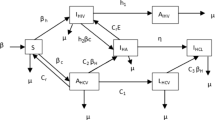Abstract
This article describes how mathematical models can be used to depict the number of people who have been tested for the deadly coronavirus that is currently sweeping the globe. It also includes information about the number of people who have been diagnosed with the virus, as well as the number of people who have recovered from it. It is unknown whether or if long-term immunity is imparted by beating a COVID-19 infection, and if so, for how long. We hope this study will help us forecast the outbreak more precisely in future. We create a mathematical model that describes the dynamics of a COVID-19 infection by including a class of isolation. The model’s formulation is discussed first, followed by its advantages. The suggested model’s (global and local) stability is proven, and it is shown to be dependent on the basic reproduction. In order to numerically solve the suggested model, the Legendre spectral method is used, where the convergence orders of the proposed method is \(N^N\), which is higher than finite difference and finite element methods. Moreover, a visual representation of the findings is presented. Our findings provide more evidence that interpersonal interaction among humans contributes to the dissemination of COVID-19 pandemic. As a result, isolating the affected individual may reduce the spread of COVID-19 in the future.








Similar content being viewed by others
Data Availibility Statement
No Data associated in the manuscript.
References
A. Zeb et al., Mathematical model for coronavirus disease 2019 (COVID-19) containing isolation class. Biomed. Res. Int. (2020). https://doi.org/10.1155/2020/3452402
J. Cao et al., Clinical features and short-term outcomes of 18 patients with corona virus disease 2019 in intensive care unit. Intensive Care Med. 46(5), 851–853 (2020)
J. Cao et al., Clinical features and short-term outcomes of 102 patients with coronavirus disease 2019 in Wuhan, China. Clin. Infect. Dis. 71(15), 748–755 (2020)
W-K. Ming, H. Jian, J.P.Z. Casper, Breaking down of healthcare system: mathematical modelling for controlling the novel coronavirus (2019-nCoV) outbreak in Wuhan, China. BioRxiv (2020)
B. Milan, Estimation of the final size of the coronavirus epidemic by the logistic model (Update 4). Technical report (2020)
V. A. Okhuese, Mathematical predictions forcoronavirus as a global pendamic. Res. Gate (2020)
P. Van den Driessche, W. James, Further notes on the basic reproduction number. Math. Epidemiol. 1945, 159–178 (2008)
E.M. Ronald, Nonstandard finite difference models of differential equations (World Scientific, London, 1994)
R.E. Mickens, Calculation of denominator functions for nonstandard finite difference schemes for differential equations satisfying a positivity condition. Numer. Methods Partial Differ. Equ.: Int. J. 23(3), 672–691 (2007)
G.U. Nneji, et al., Enhancing low quality in radiograph datasets using wavelet transform convolutional neural network and generative adversarial network for COVID-19 identification. in 2021 4th International Conference on Pattern Recognition and Artificial Intelligence (PRAI). IEEE, (2021)
Y.E. Erdogan, A. Narin, COVID-19 detection with traditional and deep features on cough acoustic signals. Comput. Biol. Med. 136, 104765 (2021)
V. Despotovic, M. Ismael, M. Cornil, R. Mc Call, G. Fagherazzi, Detection of COVID-19 from voice, cough and breathing patterns: dataset and preliminary results. Comput. Biol. Med. 138, 104944 (2021)
B.B. Hazarika, D. Gupta, Modelling and forecasting of COVID-19 spread using wavelet-coupled random vector functional link networks. Appl. Soft Comput. 96, 106626 (2020)
I. Nesteruk, Estimations of the coronavirus epidemic dynamics in South Korea with the use of SIR model (Preprint, ResearchGate, 2020)
S.U. Khan, I. Ali, Application of Legendre spectral-collocation method to delay differential and stochastic delay differential equation. AIP Adv. 8(3), 035301 (2018)
S.U. Khan, M. Ali, I. Ali, A spectral collocation method for stochastic Volterra integro-differential equations and its error analysis. J. Adv. Differ. Equ. 1, 161 (2019)
S.U. Khan, I. Ali, Numerical analysis of stochastic SIR model by Legendre spectral collocation method. Adv. Mech. Eng. 11, 7 (2019)
I. Ali, S.U. Khan, Analysis of stochastic delayed SIRS model with exponential birth and saturated incidence rate. Chaos Solitons Fractals 138, 110008 (2020)
S.U. Khan, I. Ali, Convergence and error analysis of a spectral collo-cation method for solving system of nonlinear Fredholm integral equations of second kind. Comput. Appl. Math.. 38(3), 125 (2019)
S.U. Khan, I. Ali, Applications of Legendre spectral collocation method for solving system of time delay differential equations. Adv. Mech. Eng. 12(6), 1687814020922113 (2020)
N. Gul et al., Transmission dynamic of stochastic hepatitis C model by spectral collocation method. Comput. Methods Biomech. Biomed. Eng. 25(5), 578–592 (2022)
Asad Ali et al., On dynamics of stochastic avian influenza model with asymptomatic carrier using spectral method. Math. Methods Appl. Sci. 45(13), 8230–8246 (2022)
I. Ali, S.U. Khan, Threshold of stochastic SIRS epidemic model from infectious to susceptible class with saturated incidence rate using spectral method. Symmetry 14(9), 1838 (2022)
X. Meng, L. Chen, B. Wu, A delay SIR epidemic model with pulse vaccination and incubation times. Nonlinear Anal. Real World Appl. 11(1), 88–98 (2010)
Y. Song, A. Miao, T. Zhang, X. Wang, J. Liu, Extinction and persistence of a stochastic SIRS epidemic model with saturated incidence rate and transfer from infectious to susceptible. Adv. Differ. Eqnarrays 2018, 293 (2018)
Author information
Authors and Affiliations
Corresponding author
Rights and permissions
Springer Nature or its licensor (e.g. a society or other partner) holds exclusive rights to this article under a publishing agreement with the author(s) or other rightsholder(s); author self-archiving of the accepted manuscript version of this article is solely governed by the terms of such publishing agreement and applicable law.
About this article
Cite this article
Khan, S.U., Jan, F., Sirisubtawee, S. et al. Dynamics and simulation of stochastic COVID-19 model using higher-order numerical scheme. Eur. Phys. J. Plus 138, 667 (2023). https://doi.org/10.1140/epjp/s13360-023-04286-6
Received:
Accepted:
Published:
DOI: https://doi.org/10.1140/epjp/s13360-023-04286-6




